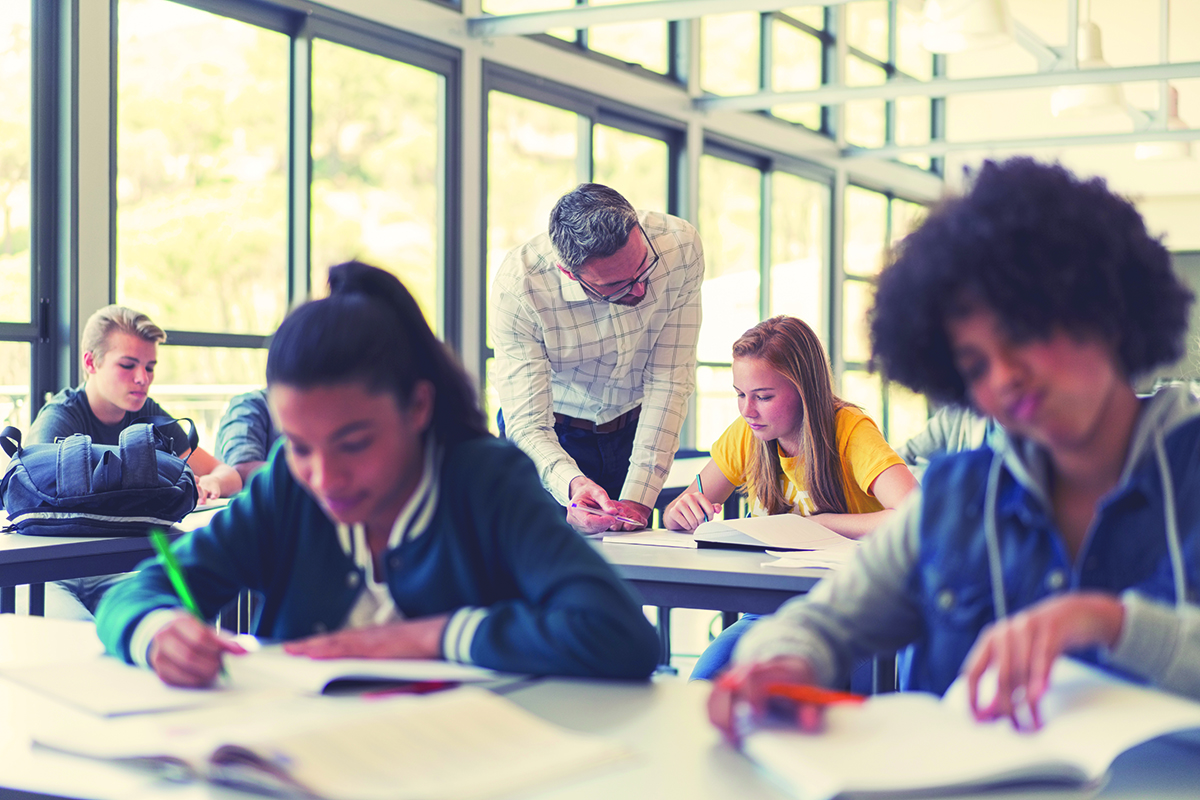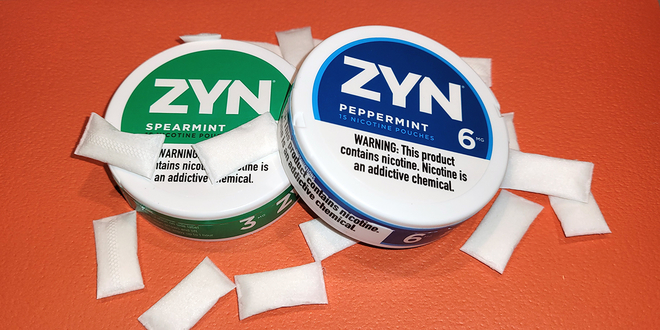
A classroom crisis: How the youth vaping epidemic is impacting teachers
As the youth vaping epidemic continues to surge, schools are playing a central role in confronting and addressing the crisis. Teachers say youth vaping is impacting their ability to educate students because of frequent class interruptions, decreased student focus and few resources to help them address the problem, according to new Truth Initiative® research. Teachers report “constant disruptions,” viewing students vaping as “second nature, like breathing,” and changes regarding students’ attention span, focus and self-control. Many said they were “extremely concerned” about their students vaping and see it as a growing problem that teachers need more support and training to face, with one stating “we now feel like we are almost like prison guards looking for contraband.”
Educators are on the front line of the epidemic, interacting with youth on a near-daily basis. More than a quarter (27.5%) of high school students report vaping at least once in the last month and nearly 1 million report vaping daily, according to 2019 Centers for Disease Control and Prevention data. Altogether, more than 5 million youth now vape in the U.S. Teachers’ perspectives and experience lend valuable insight to the alarming statistics about vaping trends and health effects. Previous Truth Initiative research found that the overwhelming majority of teachers and administrators were concerned about youth vaping on school property.
With the vaping landscape continually changing, Truth Initiative examined a current snapshot of what teachers experience in schools daily. Truth Initiative convened an online discussion in October 2019 with 28 high school teachers to better understand their perspectives on how vaping impacts student behavior and academics, classroom dynamics and high school culture and practices.
Several key perspectives emerged:
- Teachers reported growing awareness of and concern about vaping.
The majority of teachers felt that vaping had become a bigger problem in their school over time and nearly half reported that they were “extremely concerned” about their own students vaping. - Vaping was reportedly so common that teachers couldn’t describe the “typical” student who vapes.
Teachers added that students have developed humorous attitudes toward vaping, suggesting that vaping has become normalized in schools. - Teachers believed vaping negatively impacted all students.
This includes those who do not vape and was most often a result of numerous classroom disruptions due to vaping. - Students were not aware of the health effects of vaping.
Teachers did not feel trained to counsel students or parents on the issue. - Vaping affected school-wide culture and teaching styles.
This occurred either through disruptions, decreased trust between staff and students or peer pressure. - Half of teachers felt their school vaping policies were ineffective.
They cited barriers to enforcement such as difficulties in detection, lack of parental support, limited resources and lack of prioritization.

Teacher experiences with student vaping across the country
Researchers recruited full-time high school teachers with at least four years of experience at schools with 300 students or more.Twenty-eight teachers from schools across four regions of the United States completed the discussion process, which was held online October 15-17, 2019, and moderated by a trained facilitator. Teachers were recruited to be representative of different age groups, ranging in age from 25 to 71 years old.
This study provides specific examples and anecdotes of what teachers in the field observed, but, like most qualitative studies, the opinions and statements presented here do not necessarily represent the sentiments of the nation at large. This study does, however, provide personal perspectives and opinions that speak to larger trends in teachers’ experiences with vaping in schools.
TEACHERS REPORT A GROWING AWARENESS OF VAPING
- Increasing awareness of vaping
Many teachers recognized the pervasiveness of vaping in schools, which reflects recent research that found 27.5% of high school students currently vape. Almost three-quarters of teachers stated that vaping has become a bigger problem in their school over time.
One teacher said that she was shocked by how many students vape or had tried vaping, and that the disproportionately high number of vaping devices that had been confiscated is indicative of a major problem. Another reported that “…students seem to do it like it’s second nature, like breathing.” Teachers also indicated that students often go to great lengths to conceal their devices, including hiding them in hoodies, hats, bras and shoes. - Concern about vaping
When asked about a prominent health issue that their students face, a quarter of teachers independently mentioned vaping. Almost all teachers were very or extremely concerned about students vaping within the school building or on school grounds. Nearly half were “extremely concerned” when asked specifically about their own students vaping. - Where students vape
Teachers expressed concern about vaping in bathrooms and stairwells, and many teachers also reported disruptive instances of students vaping in the classroom.
“The main problems, and reasons for such high numbers, are that [vaping] is easy to do anywhere and there is no awareness about health risks.”
VAPING HAS BECOME NORMALIZED
Teachers reported that vaping affected all types of students, contributing to a new “normal.” Many teachers characterized vaping as a new form of peer pressure. One suggested that students who were stressed were moving toward vaping products that are harmful, addictive and have serious health consequences.
- The typical “vaper”
Many teachers reported that there was no single type of student who vapes. - Student normalization
Teachers reported that students had adopted casual, humorous attitudes toward vaping. “Many students just kind of shrug their shoulders about it.” Another said: “I think most seem to think of [vaping] as a joke. They’ve made memes and posted them in the bathroom saying things like “NO PEEING IN THE JUUL ROOM!”
“Over the past few years, it’s gotten out of control. Whereas before you would just see small groups of students vape, now it’s become so popular and accessible that it’s about as common as holding a cup of coffee. It’s spreading.”
VAPING NEGATIVELY IMPACTS ALL STUDENTS — INCLUDING THOSE WHO DO NOT VAPE
Teachers explained that vaping adversely affects not only the performance of students who vape but also the learning environment of students who do not vape. Teachers reported that frequent classroom disruptions, disciplinary problems and peer pressure to vape regularly impeded daily learning for all students.
- Classroom disruptions
Many of the teachers in this study described interruptions resulting from student vaping. One teacher described vaping as a daily disruption, impacting other students in addition to the teacher.
“Constantly asking to leave the class and being pulled out to talk to [administration] and resource officer, it disrupts not only the student but everyone else in class. Constant disruptions cause learning to go by the wayside. My students are not getting the time and attention they deserve in class to learn.”
Another teacher described an episode when a student pulled out his vaping device in class and took a puff, prompting another student to do the same shortly after. The teacher reported that it took the class 15 minutes to recover from the incident. - Behaviors and disciplinary issues
A large majority of teachers said vaping had caused behavior or disciplinary problems, and half said it had affected student attendance or tardiness. Teachers reported that students vaped in the classroom at any time, from when teachers had their backs turned to during the middle of science experiments. One teacher said that students were late to class because they went outside to vape. Another reported that it could be difficult to let students leave class because they didn’t know if they were going to the restroom or to vape. - Effect on academic performance
Almost one-third of teachers said vaping had affected academic performance. Teachers observed vaping’s impact on students through apparent nicotine dependency and behavioral changes. One teacher described nicotine dependency in students who vape:
“…quite a few students are addicted and the scary thing is they don’t think they are … a kid showing signs of addiction has mood swings (that they may or may not have had before), sudden drop in grades or loss or change of friend groups.”
Another teacher reported students’ lack of concern for missing or late assignments and their socializing with the “wrong” group of students, which ultimately affected academic performance. - Peer pressure to vape
Teachers noted that students who do not vape faced peer pressure from and frustration toward those who do. They expressed concern that these students were “inundated by negative behavior just by being a student,” and faced social pressure to vape through the normalization of vaping.
In one instance, student athletes who did not vape were upset at their teammates who vaped when they noticed it affected their teammates’ rowing performance.
STUDENTS ARE UNAWARE OF HEALTH RISKS
- Unaware of the health risks and harms associated with vaping
One teacher reported having students who were unaware that e-liquids contain harmful chemicals.
“They had no idea they were vaping nicotine. They were also unaware of the dangers and addictiveness of nicotine. Students must learn at a very early age the danger of nicotine and the fact that e-cigarettes contain this chemical.”
Teachers’ reports are in line with Truth Initiative research, which showed that nearly two-thirds of JUUL users aged 15-21 were not aware the product always contains nicotine. In addition to nicotine’s negative effects on developing brains, recent studies have found harmful effects of vaping on both lung and cardiovascular health.
VAPING AFFECTS SCHOOL-WIDE CULTURE AND TEACHING STYLES
- Change in teaching style
The majority of teachers said that vaping had affected their teaching style. One teacher reacted to frequent vaping-related disruptions by moving from inquiry- and project-based teaching to a more structured lecture/note-taking style.
“…I have noticed students coming to my class right after having vaped. Their attention span and focus was noticeably affected, affecting the classroom dynamics and even my teaching goals for the day.” - School culture change
The majority of teachers said vaping had changed school culture, either through disruptions, decreased trust between staff and students or peer pressure. More than two-thirds of teachers believed vaping had impacted school events, and more than one-third believed it had impacted clubs, teams or activities.
TEACHERS EXPRESSED A NEED FOR MORE SUPPORT AND EXPANDED SCHOOL POLICIES
Half the teachers felt their school vaping policies were ineffective, citing barriers to enforcement, such as difficulties in detection, lack of parental support, limited resources and lack of prioritization.
- Difficulty finding students’ vapes
Teachers struggled due to the devices’ discreet properties. Reflecting the experience of teachers nationwide, teachers in this study reported that the latest vapes are easy to hide, odorless and that student privacy rights presented a hurdle in finding the devices. Data from a national study of teachers and administrators in schools with vaping policies showed that vaping devices’ properties added to the difficulty in enforcing school regulations, with most school staff reporting the discreet appearance of devices (66%) and difficulty in determining the source of the vapor or scent (46%) as barriers to enforcement.
“We can’t enforce what we can’t see, so anytime privacy stands in the way of enforcing the rules, students’ decisions will always win out.”
Previous research by Truth Initiative found that less than half of middle and high school teachers and administrators in a national sample could identify a photo of a JUUL. One teacher from the online discussion reflected this difficulty, noting that JUUL vapes resembled USB flash drives, making it hard for an untrained eye to see them. It also didn’t help that the smoke is odorless:
“Originally vape smoke was so easy to distinguish both through sight and smell but now it can be almost completely clear and almost completely odorless.” - Lacking parental support
Teachers who tried to stop students from vaping in school may not have parental support on the issue, suggesting that communication about the risks of vaping aren’t reaching all the audiences necessary to make an impact. According to recent research, this disconnect is common. More than two-thirds (66%) of teachers/administrators said their school communicated with parents about vaping, but only 26% of parents reported that their child’s school communicated with them about vaping. - Limited resources to address vaping
One teacher reported that lack of support staff contributed to their school’s inability to regulate vaping:
“We barely scrapped [sic] enough money in the budget to get one hall monitor and administration is relying on teachers volunteering their prep time to check bathrooms.”
“We now feel like we are almost like prison guards looking for contraband.”
TEACHERS ARE NOT TRAINED TO PROVIDE HEALTH INFORMATION OR ACT AS SECURITY GUARDS
- Lacking school policy change
Teachers in this study reported that most school policies haven’t really changed as a result of the vaping epidemic. Instead, vaping was just added to existing policies banning smoking or drinking.
The majority of teachers hadn’t implemented new classroom rules to address vaping, and those who did implement rules introduced bathroom policies, such as restrictions on length of bathroom breaks and limitations on the number of breaks permitted during a semester, not allowing students to take cell phones with them to the restroom, and only allowing two students to go to the bathroom at a time. - Scarce involvement to discipline
Teachers often ended up filling the role of police officers or security guards, with discipline largely left up to administration. One teacher described this as “above a classroom teacher’s job” and suggested that administration and security needed to be more involved. - Need for more knowledge and training about vaping
Teachers felt they had a lack of training and education about vaping. Most teachers said they were told to report vaping to administrators, but they were not trained to educate students about the harms of vaping. - Finding a new solution
Teachers proposed vaping education at younger ages and student empowerment and engagement as solutions.
“What [students] do appreciate is respect, being treated like adults and being given opportunities and encouragement to think deeply. I think that’s the way to go. Awareness, responsibility and empowerment … it should be the students themselves organizing awareness campaigns and developing other programs to combat this dangerous trend.”

TEACHERS CAN PLAY A CRITICAL ROLE IN DISCOURAGING VAPING BUT NEED MORE SUPPORT
Teachers are on the frontline of the vaping epidemic and, alongside counselors, nurses, parents and other stakeholders, are uniquely positioned to help stem the tide of rising use. Although recent research from the CDC reported that 27.5% of high school students vaped at least once in the last month, several teachers believed that this estimate was low and that the percent of their students who vape was significantly higher. This is particularly concerning given the recent health illnesses tied to vaping, which underline the urgency in understanding the vaping epidemic.
While many teachers recognized that vaping is a problem that affects all of their students as well as their ability to teach, half did not feel that their school had effective policies to prevent its use. The vaping epidemic diverts valuable resources from the core mission of teachers and schools — to educate students — by asking strained teachers to instead monitor their classrooms for vaping, punish those who do, override consistent disruptions, educate students about health effects and work in partnership with parents who themselves may not be aware of problems.
Teachers can make a critical difference but need the tools to do so, including guidance on amending curriculum to include vaping and training on health harms related to vaping. Teachers need support not only from schools to develop and enforce effective policies and institute productive parent communications, but also from local, state and federal partners to help stem the tide of youth use. Providing new youth e-cigarette prevention resources to high school and middle school students is a start, but more can and should be done. Policies including advertising restrictions and retail policies that prevent tobacco sales near schools and to minors can also help to discourage teen vaping. Together we can help teachers help their students and focus on what they do best.








